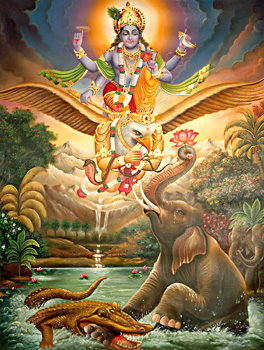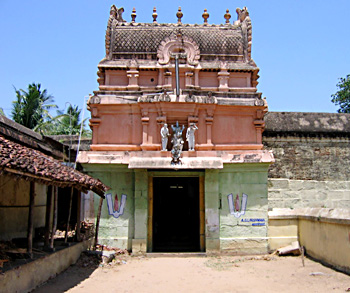 Gajendra Moksham is the name of the well-known elephant and it is believed that his cries for help in difficulty dragged down the Lord Vishnu from his heavenly abode. Even if the story is plotted in the Tamil Nadu temple of Kapisthalam, this narrative forms one of the central themes of a large number of famous mural paintings in Kerala and which is why the same is very popular in each and every household of the Indian state of Kerala. One of the well-known mural paintings is at the Krishnapuram Palace, which is located on the way between Alleppey and Kollam, a place famously called Kayamkulam. This is a marvellous, massive mural which dates back to the eighteenth century and is also one of the oldest of the region.
Gajendra Moksham is the name of the well-known elephant and it is believed that his cries for help in difficulty dragged down the Lord Vishnu from his heavenly abode. Even if the story is plotted in the Tamil Nadu temple of Kapisthalam, this narrative forms one of the central themes of a large number of famous mural paintings in Kerala and which is why the same is very popular in each and every household of the Indian state of Kerala. One of the well-known mural paintings is at the Krishnapuram Palace, which is located on the way between Alleppey and Kollam, a place famously called Kayamkulam. This is a marvellous, massive mural which dates back to the eighteenth century and is also one of the oldest of the region.
Indradyumna, the Pandya King, is known to have prayed Lord Vishnu or Narayana with a fervor which is much higher as compared to the ordinary man. But the king was very unfortunate and for some reason or the other, he was subjected to earn the displeasure of Sage Druvasa. The famous sage cursed the king to get the next birth in the class of animals. After hearing this curse from the Sage, King Indradyumna broke down into tears and pleaded the Sage to take back his curse since in the form of and animal he will not be able to offer his daily prayers to his beloved Lord Vishnu, since he believes his prayers and offerings to his lord is much greater than his own life and soul. Highly motivated by such a piety from such a great king, the sage Druvasa blessed Indradyumna to be born as an elephant and also promised him that his devotion towards the Lord will remain the same even in the animal form. The great sage also promised Indradyumna that he would attain deliverance by the blessings of Lord Vishnu.
There was a demi-god by the name of Huhu, who was subjected to the wrath of Maharishi Devalar and was given a curse to get birth in the world as a crocodile. There is a belief that the ancient Indian sages were very much kind and highly benevolent and after cursing someone they immediately repent for being cursed. Thus, Rishi Devalar too lowered the force of his curse as well by giving assurance to Huhu that his liberation from the life of a crocodile would be done by none other than Lord Vishnu.
 After getting the curse from Sage Druvasa, Indradyumna was born in the elephant form and was known as Gajendra but his love and devotion towards the Lord Vishnu remained the same as promised by the sage. Each and very morning, Gajendra would pluck a lotus with the help of his trunk from a water tank and then he offers the same to the Lord. He was a benevolent elephant king and was accompanied by his herd every morning in his ritual before the Lord. There was one such morning, when Gajendra moved inside the sacred tank in order to take bathe and collect a pink blossom which he would offer his beloved Lord as the offering of the day, a large crocodile caught hold of his foot and dragged the elephant slowly into the water. The entire herd led by Gajendra unitedly tried to set Gajendra free from the grip of the predator but the crocodile was so powerful that the entire herd of elephants failed in their attempt. There was a belief that the very crocodile which caught the foot of Gajendra was the demi-god Hunu who was born as a result of the curse from Maharishi Devalar.
After getting the curse from Sage Druvasa, Indradyumna was born in the elephant form and was known as Gajendra but his love and devotion towards the Lord Vishnu remained the same as promised by the sage. Each and very morning, Gajendra would pluck a lotus with the help of his trunk from a water tank and then he offers the same to the Lord. He was a benevolent elephant king and was accompanied by his herd every morning in his ritual before the Lord. There was one such morning, when Gajendra moved inside the sacred tank in order to take bathe and collect a pink blossom which he would offer his beloved Lord as the offering of the day, a large crocodile caught hold of his foot and dragged the elephant slowly into the water. The entire herd led by Gajendra unitedly tried to set Gajendra free from the grip of the predator but the crocodile was so powerful that the entire herd of elephants failed in their attempt. There was a belief that the very crocodile which caught the foot of Gajendra was the demi-god Hunu who was born as a result of the curse from Maharishi Devalar.
After a very long struggle, the elephant king Gajendra became very weak and was dying. This struggle between the crocodile and the elephant Gajendra continued for thousand years. After the completion of thousand years of struggle in between the elephant and the crocodile, Gajendra started to tire but the strength of the crocodile remained the same as before. The elephant lost too much blood and thus became extremely weak. At last, he realized that at this juncture of time he can only be saved by none other than the Lord himself. There is a belief that Gajendra cried, "Adi Moolam", and this call was heard by the Lord. After hearing the cry of his disciple in distress, Lord Vishnu suddenly appeared before Gajendra while riding on his vahana or vehicle, Garuda. Then, he immediately ordered his Sudarshana Chakra to kill the crocodile and save the elephant, which the chakra did as well. After being free from the deadly clutches of the crocodile, Gajendra offered his Lord a Lotus flower and expressed his sincere gratitude for freeing him from the hands of death. After the cunning crocodile was killed by the Sudarshana Chakra of Lord Vishnu, Gajendra attained his human form. Thus, in this manner the two prophecies of the redemption of Hulu and the liberation of Gajendra became true.
The well-known and renowned Srimad Bhagavatham, the famous Hindu epic also bears a very good narrative of this legendary tale and holds that Gajendra had composed verses in the praise of the Lord Vishnu while he was in extreme difficulty in the water tank due to the deadly clutches of the crocodile from which he could not free himself. There is a very famous belief among people that whosoever narrates the entire tale or legend of this elephant that was caught by the crocodile in the Bhagavatham and benevolently worship the god are made free from the sins and sufferings in the same way as Gajendra was freed from the problem. The moral of this legend of Kerala is that the supreme power is the devotion and faith towards the Lord and this tale is narrated before the young minds of Kerala in order to create in them trust and awe in the Divine.



















